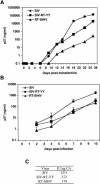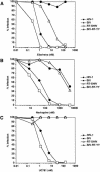In vitro characterization of a simian immunodeficiency virus-human immunodeficiency virus (HIV) chimera expressing HIV type 1 reverse transcriptase to study antiviral resistance in pigtail macaques
- PMID: 15564466
- PMCID: PMC533891
- DOI: 10.1128/JVI.78.24.13553-13561.2004
In vitro characterization of a simian immunodeficiency virus-human immunodeficiency virus (HIV) chimera expressing HIV type 1 reverse transcriptase to study antiviral resistance in pigtail macaques
Abstract
Antiviral resistance is a significant obstacle in the treatment of human immunodeficiency virus type 1 (HIV-1)-infected individuals. Because nonnucleoside reverse transcriptase inhibitors (NNRTIs) specifically target HIV-1 reverse transcriptase (RT) and do not effectively inhibit simian immunodeficiency virus (SIV) RT, the development of animal models to study the evolution of antiviral resistance has been problematic. To facilitate in vivo studies of NNRTI resistance, we examined whether a SIV that causes immunopathogenesis in pigtail macaques could be made sensitive to NNRTIs. Two simian-human immunodeficiency viruses (SHIVs) were derived from the genetic background of SIV(mne): SIV-RT-YY contains RT substitutions intended to confer NNRTI susceptibility (V181Y and L188Y), and RT-SHIV(mne) contains the entire HIV-1 RT coding region. Both mutant viruses grew to high titers in vitro but had reduced fitness relative to wild-type SIV(mne). Although the HIV-1 RT was properly processed into p66 and p51 subunits in RT-SHIV(mne) particles, the RT-SHIV(mne) virions had lower levels of RT per viral genomic RNA than HIV-1. Correspondingly, there was decreased RT activity in RT-SHIV(mne) and SIV-RT-YY particles. HIV-1 and RT-SHIV(mne) were similarly susceptible to the NNRTIs efavirenz, nevirapine, and UC781. However, SIV-RT-YY was less sensitive to NNRTIs than HIV-1 or RT-SHIV(mne). Classical NNRTI resistance mutations were selected in RT-SHIV(mne) after in vitro drug treatment and were monitored in a sensitive allele-specific real-time RT-PCR assay. Collectively, these results indicate that RT-SHIV(mne) may be a useful model in macaques for the preclinical evaluation of NNRTIs and for studies of the development of drug resistance in vivo.
Figures






References
-
- Akiyama, H., E. Ido, W. Akahata, T. Kuwata, T. Miura, and M. Hayami. 2003. Construction and in vivo infection of a new simian/human immunodeficiency virus chimera containing the reverse transcriptase gene and the 3′ half of the genomic region of human immunodeficiency virus type 1. J. Gen. Virol. 84:1663-1669. - PubMed
-
- Balzarini, J. 1999. Suppression of resistance to drugs targeted to human immunodeficiency virus reverse transcriptase by combination therapy. Biochem. Pharmacol. 58:1-27. - PubMed
-
- Balzarini, J., W. G. Brouwer, D. C. Dao, E. M. Osika, and E. De Clercq. 1996. Identification of novel thiocarboxanilide derivatives that suppress a variety of drug-resistant mutant human immunodeficiency virus type 1 strains at a potency similar to that for wild-type virus. Antimicrob. Agents Chemother. 40:1454-1466. - PMC - PubMed
-
- Balzarini, J., L. Naesens, E. Verbeken, M. Laga, L. Van Damme, M. Parniak, L. Van Mellaert, J. Anne, and E. De Clercq. 1998. Preclinical studies on thiocarboxanilide UC-781 as a virucidal agent. AIDS 12:1129-1138. - PubMed
-
- Balzarini, J., M. Weeger, M. J. Camarasa, E. De Clercq, and K. Uberla. 1995. Sensitivity/resistance profile of a simian immunodeficiency virus containing the reverse transcriptase gene of human immunodeficiency virus type 1 (HIV-1) toward the HIV-1-specific non-nucleoside reverse transcriptase inhibitors. Biochem. Biophys. Res. Commun. 211:850-856. - PubMed
Publication types
MeSH terms
Substances
LinkOut - more resources
Full Text Sources
Other Literature Sources
Medical

